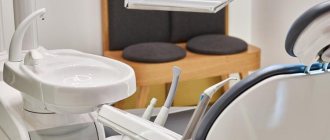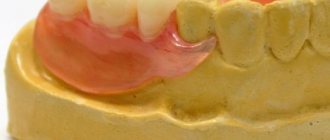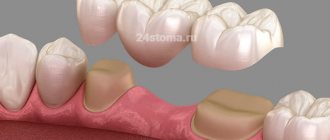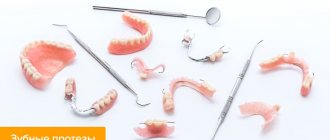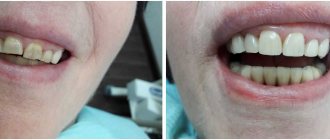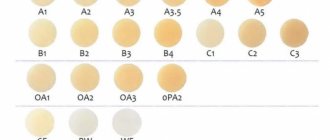Restoring the jaw, increasing aesthetic appeal, and replacing damaged areas of the masticatory organs is usually performed by a qualified doctor. However, to make the right decisions, the patient must know: what materials, types of prosthetics and designs exist for removable and permanent dentures in dentistry.
You should know that you need to visit the doctor twice a year, and not when everything in your mouth starts to hurt. Pain is a direct sign that caries is developing with other complicating diseases, chips, cracks and other damage appear that require immediate intervention. Timely prevention prevents bacterial development, allows you to find the problem at an early stage, and prevent large-scale destruction. Everyone should understand: neglecting the advice provided leads to the development of big problems.
Main categories
What is a denture? It is an artificial implant that replaces living bone. They are divided into the following types: removable, non-removable and partially removable. To choose the right one, it is necessary to diagnose dental damage and determine the method of treatment.
Only a dentist can prescribe certain actions (operations) in the oral cavity. Self-medication is more likely to only cause harm and cause the situation to worsen.
Filmed
Used after the loss of a large number of living teeth. The main feature of such prostheses is the ability to take them off and put them on yourself at home.
This type of prosthetics solves two problems:
- Restores a section of a row - an acrylic or nylon implant is fixed to living supporting teeth (important requirements for the constituent components: lightness and strength).
- Restores the bite in cases of complete edentia - small implants are installed in the oral cavity and serve as the basis for the movable part. Two years later, after the onset of alveolar atrophy, the entire chewing area needs to be replaced (discomfort or pain may appear).
Fixed type of dentures
- The metal-ceramic structure is expensive and durable, and in terms of aesthetic indicators it is 100% similar to the original, living units.
- The metal base is quite strong, but does not look so beautiful.
- Ceramics - looks expensive, loses in the long run.
- Zirconium dioxide is a modern component, enhanced with ceramic components (it is often used, but the human body can reject it).
- Plastic is fragile, short-lived (up to 5 years), used only for small loads, unstable color spoils aesthetics (advantage: low cost).
Fixed dentures evenly distribute pressure on the jaw, help preserve speech without defects, preserve beauty for a long time, and strengthen the resistance of the oral cavity to external damage.
The main disadvantage of this approach is expensive installation, possible painful sensations during operation, and exacerbation of allergic reactions. Before making such a choice, you should consult with a qualified dentist.
To learn everything about dental prosthetics, types and features, you can sign up for a consultation through the Dentika clinic website.
Conditionally removable
The patient can independently remove the jaw restored with such a prosthesis, or contact a dentist for these manipulations. The method is used where bridge orthopedics is powerless and there are contraindications to it.
The advantages include: ease of use, reliable fastenings, increased durability, beautiful aesthetics, elimination of any deformation.
The complexity of the installation of such systems, the high cost due to the addition of additional procedures, caring for the mechanism requires regular visits to the doctor, the clamps must be replaced every year - these are the disadvantages of this method.
Removable prosthetics
To avoid depulpation, removable dentures are used.
There are 2 large groups of partial removable dentures: plate
and
clasp ones
. The main difference is the presence of a metal arc in the latter. The arch more or less evenly distributes the chewing load without overloading the supporting teeth.
Lamellar
Their task is to replenish the dentition and relieve the remaining teeth at the expense of the base. The base rests on the jaw and palate, taking on part of the load, but such dentures cannot fully take on the chewing load.
Fixation methods: clasps, clasps, attachments. For the upper jaw, the prosthesis is equipped with a palatal plate, which ensures tight suction.
The following products are made from polymer materials:
- Acrylic
The rigid base distributes the load, but is not very comfortable to wear. It takes a long time to get used to such structures. Acrylic wears out quite quickly, becomes cracked and shrinks slightly. Such a product must be changed at least once every 5 years. The main disadvantage is the presence of substances that can cause allergies.
- Nylon
The material is flexible, it is not so difficult to get used to it and the feeling in the mouth is more comfortable. But when chewing it sags and distributes the load worse than acrylic. Hypoallergenic, biocompatible, nylon lasts longer than acrylic.
- AcryFree
is a new polymer that combines the advantages of the previous ones. It is tough like acrylic, but hypoallergenic like nylon.
Clasp
Artificial teeth are attached to a metal arch. It strengthens the entire dentition, acting as a splint. The fastenings are the same as for plate structures: clasps, telescopic crowns, attachments. They are made from alloys of cobalt and chromium, precious metals, and titanium.
Technological research has made it possible to produce clasp dentures without the use of metal.
Quadrotti prostheses are made of durable polymer. It is light, but so strong that the base of it is smaller than that of ordinary clasps and the palatal bridge is very narrow. If 1-2 teeth
, in a prosthesis without turning, they do without an arch.
Types of implants
Classification by type of use is not the only thing that needs to be taken into account when carrying out such work. Quality and durability depend on the materials for removable and permanent dentures.
Bridge-like
The complex system is attached to supporting (undamaged) elements. It consists of clasps with special tabs onto which artificial implants are fixed.
Bridges are divided into separate groups according to their components: plastic, metal-ceramics, ceramics, metal. The last three materials should be highlighted due to their beauty, good strength and durability.
In the absence of contraindications, the inner part of the root is made of zirconium dioxide. Durable, resistant to the aggressive environment of the oral cavity, the material completely imitates enamel.
Only a dentist can determine the advisability of using this approach, based on individual components: tolerance to various substances and characteristics of the jaw, including the strength and shape of the bite.
On implants
Metal connects living tissues with a future artificial organ. Available only in non-removable versions. The rods serve as a reliable fastening for installation.
Capital, with a neat appearance, anti-allergenic, durable - implants are inferior only in cost, rehabilitation process and contraindications (for example, weak gums).
Butterfly dentures
A complex design that requires a careful approach to insertion and operation. It got its name because of its resemblance to an insect, and is used only for fragmentary restoration. It is attached to adjacent teeth, so it cannot be used if they are completely or partially lost.
Simple and cheap to install, they have a short service life and cause some discomfort to their owner.
Coronal
Preserve the root while restoring the outside. The solution allows you to extend the life of your natural teeth and has the following advantages:
- Complete resemblance to a real chisel (impossible to distinguish).
- Effective where fillings and extensions do not work.
- Uniform load distribution helps to preserve adjacent elements.
- A bridge allows you to simultaneously restore your bite.
- There are virtually no side effects.
Any damage to the root prohibits the use of a crown. Turning an entire part is a complex job that must be carried out by a qualified specialist.
Clasp
Stainless steel (nichrome) is used to make the frame. According to the principle of treatment and application, it is completely similar to plastic options.
The system is attached to the supporting parts using locks. Implants can be used, which allows the use of clasps in case of complete loss of teeth. It preserves taste buds, and the prosthesis is very reliable thanks to the locking fixation.
This type should be carefully determined for use - it has contraindications due to the metal insert, and the frame is visible to others.
Lamellar
The jaw is divided into two components (upper and lower plates). The removable base is attached to the gums through suction cups, the cost of which depends on the quality of the components.
They are easy to produce, low in price, and can be used for extensive lesions - they cause great discomfort (increased load on the alveoli, may fall out), have side effects and a short service life. In the laboratory, the model is recreated for each person using a unique cast.
There is no point in choosing expensive components for plates, since the model wears out quickly.
Sandwiches
A hybrid that brings together all the best from clasp and plate types of prosthetics. Without visible fragments, such plates are easy to use (even with complete edentia).
Conclusion.
The selection and application of artificial teeth based on information about both functional processes and functional patterns corresponding to nature is an absolute necessity - after all, who doesn’t want to live a full life, enjoy a great menu and a beautiful smile? (Fig. 30-32)
Rice. 30–32 Our goal is harmony between function and aesthetics. For the benefit of patients and, finally, ourselves, for motivation for the next correct restoration.
If you want to be happy, Give happiness to everyone around, Good, once done, Closes a full circle.
“Willst Du glücklich sein im Leben, trage bei zu anderer Glück, denn Freude, die wir geben, kehrt ins eigene Herz zurück”
(Johann Wolfgang Goethe)
Varieties by type of fastening
Artificial restoration of the bite is completed after the installation of implants. Depending on the methods of fixation, the components used and the design, there are several types in the classification of dentures and dentures:
- spherical - convenient for using partially removable systems; two supports are enough to evenly distribute the load on the closed jaws;
- beam – screwing points for implants are determined (based on the force of pressure on the gums), a beam is fixed to the holders;
- clasp - installed on supporting organs using hooks;
- on implants - it is recommended to use metal retainers as opposed to cement when there are no contraindications;
- micro-locks – the main advantage is the ability to install locks on crowns and entire areas without preliminary grinding;
- suction cups - light and short-lived with a fairly cheap implementation.
Components for the production of implants
Laboratories are working to create new approaches that will determine the quality of the future product, service life, owner comfort, the development of allergic reactions and other indicators. Which material is better for dentures for dental prosthetics?
Acrylic
Affordable – the most common today. Fixed to the surface via a hook, eliminating grinding. Using this option is justified only for temporary solutions, pending the manufacture of a permanent filling or part of it.
Acry-free
The acrylic-free polymer component is resilient and elastic and does not cause any discomfort to its owner. Scientists claim a service life of 10 years, which adds points. However, it is rarely used for long-term artificial jaws, despite the fact that the transparent base is invisible to others.
At the initial consultation, the doctor will tell you what material and type of prosthesis is best to use for dental prosthetics in each individual case.
Nylon
Widely used in any medical practice due to its lightness, flexibility, as well as elasticity and elasticity.
But even distribution of the load on the chewing organs is impossible due to their great softness (which leads to the need for immediate replacement). Recommended for temporary solutions while work is underway on a permanent prosthesis.
Zirconium dioxide
A biologically compatible artificial component that is comparable in strength to metals. Used for the manufacture of crowns, implants, and various systems for a long time.
Ceramics
Ideal for the outside of teeth on a zirconia or other metal framework. Cheaper than analogues, has an average service life - which makes the material the most widely used.
Metal alloys
The composition includes durable hypoallergenic components. The main property is oxidation resistance. Used for clasp, frame and beam implants. After ceramics, the most common option. Before carrying out work, it is necessary to consult with qualified dentists, due to the risk of material rejection.
Adhesive bridge
There are no crowns in this design, therefore, there is no need to grind down the teeth. The artificial tooth is attached to its neighbors using fiberglass tape “shoots.” The tape is fixed on the inside, it is not visible. A groove is cut into the tooth for the fiberglass so that the tape does not protrude above the surface and does not interfere.
The product is not strong enough to be used on chewing teeth or as a permanent denture. Typically, such a bridge without grinding adjacent teeth is a temporary measure in preparation for permanent prosthetics or implantation. If treated with care, the structure can last up to 3 years
.
Bacteria can accumulate in the bonding areas, increasing the risk of tooth decay. The prosthesis does not distribute the chewing load well; the supporting teeth are overloaded. In addition, such orthopedics does not prevent bone atrophy.
Artificial onlays - what are microprostheses?
A description of the types of dental prosthetics with dentures can be found below in the text.
Tabs
They allow you to delay the installation of the crown. A standard procedure can save damaged teeth by placing one cap at the root and another over the gum. The resulting strong base can last quite a long time. The prosthesis is made of porcelain, metal, ceramics, zirconium and various composites.
Veneers
Thin plates are attached to the outside. Designed to hide blemishes, minor defects, and whiten.
Two manufacturing methods:
- Several layers are successively applied to the enamel.
- The veneer is poured (made) in a special mold and then secured in the mouth.
The quality and service life of the finished product directly depend on the components.
Lumineers
They are more similar to veneers, but there are a number of distinctive features:
- Much thinner.
- Follows contours and performs the function of enamel.
- Microcracks are completely eliminated.
- Serve up to 20 years.
- Removable design.
Eliminates cracks, whitens and hides minor defects.
Crowns: what are they?
Depending on the composition they have indications and contraindications. Many people wonder how they are made and what they consist of dentures and their parts. Let's look at each type separately.
Metal
There are cast and stamped. They are widespread due to their low cost, as well as ease of implantation and maintenance, but have lost their relevance due to the use of more modern analogues.
They can be made of nickel, titanium, gold, silver, cobalt. The downside is complete unattractiveness.
Plastic
They are made with or without a finished frame. Attractive and beautiful design, together with simple and cheap installation, can make them leaders in application. Low strength and fragility are the main disadvantages of polymer dentures and structures. In addition, plastic is a highly allergenic component.
Used for restoration, correction of anterior incisors (low load) and temporary solutions, while a permanent option is in development.
Metal-ceramic
Metal base, in the upper layers of which a ceramic coating is applied. The most common: ideal price-quality ratio. Strength, durability, the ability to be inserted into any place are advantages. The disadvantages include a possible change in color over time (requires additional care and protection), may be rejected or lead to inflammation of the gums.
Porcelain
Porcelain implants are made using press casting followed by firing. Aesthetic, strong and durable, while completely anti-allergenic. However, the high price threshold greatly reduces the application.
Zirconium dioxide crowns
After smelting, they are able to completely copy the natural external structure of the teeth. The high cost and the impossibility of subsequent adjustments after smelting the structure make this material rare. However, high strength and durability are its advantages.
Normally functioning teeth and materials.
It was already mentioned above that there is a huge offer of artificial teeth. Upon closer examination, it becomes clear that the requirements for function and functional morphology, as they are given by nature, in most of these proposals are either not taken into account at all or are taken into account little. It does not matter how steep the individual projections are, the morphology of the teeth must be formed in such a way that functional surfaces can develop between the segments of each tooth with the help of antagonists. These surfaces have a reference direction and a reference angle (such as CE or FH) to the reference surface. This is a standard program corresponding to nature, which is included as a prerequisite in the work on Tribos SM teeth (Fig. 23). The patient can only make absolutely accurate adaptation independently. This means that artificial teeth must be made from a material that allows precise adaptation. In this case, the concepts of “wear”, “viscosity” and “hardness” play an important role (Fig. 18-22). An extremely hard material is not necessarily the first choice for such conditions. The patient does not have time to form his ideal functional model. He needs functioning teeth as quickly as possible. The material itself cannot solve many problems (Fig. 24). And therefore, artificial teeth are created from various synthetic materials suitable for the tasks, and different requirements give rise to corresponding costs (Fig. 25). The correct choice of shape for the patient goes through enormous possibilities of choice (Fig. 26, 27); selection by color should also, if possible, be carried out in different lighting conditions, since in daylight, fluorescent lamps or with simple artificial lighting of the same tooth it is possible discover different color shades. By recording patient data with appropriate recording devices (Fig. 28, 29), these defined surface patterns can be modified at low cost using analog patient data.
Which prostheses are best to choose?
Dentists can cope with tasks of any complexity. The choice of prosthetic method, material, approach to treatment, its duration and other nuances are determined only by the doctor.
According to indications
The main condition for determining approaches to therapy is the patient’s clinical condition. A professional will, first of all, focus on these conditions.
By price and budget
The second most important criterion. In dentistry, one problem can be solved in several ways. From those presented, the client can choose the option that is suitable in terms of cost, time and other criteria. This indicator also depends on what the dentures are made of.
By service life
The quality of the components used directly affects the wearing comfort and durability of the products. This factor should be taken into account when choosing an affordable option. The criterion must be on the same level as the price determination.
With complete or partial edentia
This criterion applies to diagnostics according to indications. Because the different conditions of the oral cavity and gums determine the possible destinations. A complete absence of masticatory organs requires one approach, a partial absence requires another.
On the upper or lower jaw
Different anatomical functions make adjustments to dental procedures. The doctor must take this factor into account when selecting a variety of suitable solutions.
Prosthetics without turning
Dentists are constantly striving to find alternatives to grinding. This takes a long time, is quite unpleasant, and damages the enamel. Today there are several options: implantation, removable prosthetics, adhesive prostheses. Like any method, each of them has pros and cons. Only a qualified orthopedist can decide which method is suitable in each clinical case. The doctor takes into account many factors when choosing a prosthetic method, including the anatomical features of the jaw, the location of the missing teeth, the type of defect (end, included) and many other small details that are visible only to a specialist.
- Alekperov R.B. Orthopedic dentist
Question:
I am missing one tooth, what is the best way to restore the tooth without grinding down the adjacent ones? The neighbors are healthy and have nerves.
Answer:
If there are completely healthy teeth around the defect, it is really worth considering restoration options without grinding. In this case, it is best to install a classic implant and cover it with a metal-ceramic or zirconium crown after 2-4 months.
How to choose a good doctor
Finding a doctor who will restore chewing functions is a responsible task. The qualifications of a specialist directly affect the quality of the work performed, the durability of the structure and the impressions after visiting the doctor. A doctor must combine a master of his craft and a good psychologist in one person. Many people are afraid to go to the dentist, so to create a comfortable environment for the patient, the dentist must be friendly, not fuss, and explain the stages of work. Then your visit will leave only pleasant impressions.
A professional must know: how they are made, from what material removable and permanent dentures are made, and understand the types of fasteners with classification.
The most proven way to find a dentist is to collect reviews from friends. You can also use comments about specialists and clinics involved in bite correction from the Internet. For many years, the Dentika dental center has received only positive reviews from its visitors. The main goal is to make the reception pleasant, high-quality, person-oriented with a mandatory personal approach (to bring joy and health to every patient who comes to us).
At your appointment, you can ask the doctor to show all types of modern materials for high-quality complete dental prosthetics.
Implantation
Implants are divided into removable and conditionally removable. The devices are made from materials that are most convenient for implantation into the gum tissue. Titanium, ceramics and zirconium have these characteristics.
Indications for dental prosthetics using implants:
- absence of a unit in a row;
- loss of chewing teeth;
- lack of supports for bridge prosthetics;
- impossibility of installing other non-removable structures.
A conditionally removable implant has a significant drawback - the lack of reliable fastening due to the lack of end support. But such a structure can be removed from the oral cavity, cleaned and washed.
Implantation involves the insertion of metal pins into the place of the tooth root. After the pin has healed, dental prosthetics of the crown of the tooth is performed.
The implants come with a lifetime guarantee, but not every patient can afford the procedure. For example, restoring the entire dentition will cost 2 million rubles.
